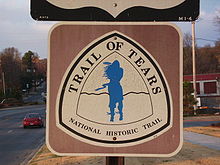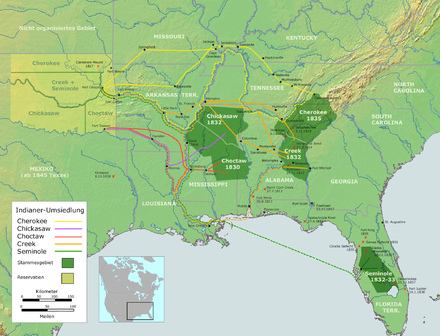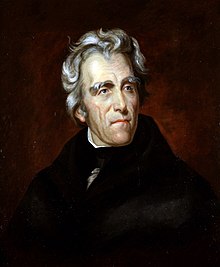Trail of Tears
![]()
Trail of Tears is a redirect to this article. For the Norwegian band see Trail of Tears (band).
The Trail of Tears (Cherokee ᎨᏥᎧᎲᏓ ᎠᏁᎬᎢ) is the term used to describe the expulsion of Native Americans ("Indians") from the fertile southeastern woodlands of the United States to the more barren Indian Territory in what is now the state of Oklahoma. The deportations of Native American tribes represent a historical watershed and mark the nadir in relations between Native Americans and the United States government.
The displacement took place against the backdrop of the European settlers' increasing demand for land from 1800 onward and the associated expansion of North American frontier lands. The relocation affected the Muskogee (Creek), Cherokee, Chickasaw, Choctaw, and Seminole peoples, also described as the "Five Civilized Nations" because of their adaptation to the colonists' way of life. In terms of United States Indian policy, legislation covered removal via the Indian Removal Act of 1830. Through treaties negotiated by President Andrew Jackson, Indian peoples were forced to cede, exchange land, or sell their ancestral lands in the southern states between 1831 and 1839, or be evicted through the use of the military.
The resettlement was organized in treks and, accompanied by American troops, followed various routes westward. On the way to the newly established Indian reservations, more than a quarter of the displaced and the African American slaves accompanying them died from disease, exhaustion, cold, and starvation. The consequences for Native peoples were devastating and extended well into the second half of the 20th century. In addition to serious decimation of the peoples, cultural and spiritual uprooting occurred for tribes closely tied to their ancestral homelands. The peoples were torn into eastern and western tribes. In the allotted territories, there was further fragmentation of peoples as well as conflict with other relocated tribes, and with the expansion of the United States into the West, further displacement.
Despite calls from Native American peoples who were affected by the removal, the United States government has not yet (as of June 2020) taken a position on any involvement in the deportation and related consequences. However, two of the Cherokee Trail of Tears routes were added to the National Trails System in 1987 to commemorate the victims.

Trail of Tears National Historic Trail

Map of the main routes
Origin of the term
The term Trail of Tears originally referred to the forcible removal of the Cherokee covered by American legislation and the relocation of the Choctaw. The Cherokee referred to the removal as Nunna daul Tsuny (cherokee for 'The Way We Cried'), which was translated into English as Trail of Tears and thus became widespread. Among the Choctaw, the expression refers to a description of their relocation quoted in the Arkansas Gazette in November 1831, which was called the "[...] trail of death and tears" by one of the prominent chiefs, presumably Thomas Harkins or Nitikechi. Other newspapers picked up and circulated this expression in a shortened form as Trail of Tears. The term was gradually adopted for the other Indian nations of the Southeast displaced under the Indian Removal Act, and is now used to describe the overall circumstances of the displacement of the Southeastern nations. Occasionally, the term is used to characterize forcible or lossful expulsions or relocations of other Indian peoples, such as the 1860 'Long March' (English: The Long Walk) of the Navajos native to the southwestern United States.
Previous story
Indian settlements in the 18th century
In the second half of the 18th century, the settlement areas of the Indians, which originally encompassed large parts of the southeastern United States, had shrunk considerably, mainly as a result of treaties and military conflicts with settlers originating from Europe. The retention of the Indians in the restricted areas was initially in the interest of the colonial powers, for whom the tribal territories were also important as buffer zones between the various spheres of influence. Especially the Cherokee and Muskogee habitat in the mountainous region of the states of Georgia, North Carolina, South Carolina, and Tennessee separated the French, Spanish, and British spheres of interest.
By 1800, the Seminoles had already been significantly decimated in sparsely populated central Florida by the First Seminole War and were influenced by the settlers of the Spanish Florida colony, while the Choctaw and Chickasaw inhabited fertile lands south of the Mason-Dixon line in Alabama and Mississippi, separating French Louisiana from the Thirteen Colonies of the British colonial power. Lack of interest on the part of white settlers saved the territories from further diminution until that time; Indian settlement areas were largely treated as autonomous state territories.
Economic changes around 1800
With the invention of the cotton gin, which enabled the effective use of slaves on plantations and thus the cultivation of cotton on a large scale, the need of the white settlers for further and large areas of cultivation in the Southeast grew. The area known as the Black Belt was of particular economic interest. This is an area of black soil suitable for cotton farming, stretching from North Carolina to Louisiana. The boom in the southern states allowed the Indian nations living in this region to become increasingly prosperous. Favorable to economic development was that the five nations had a long tradition of slaveholding. The slaves were predominantly prisoners of war or people stolen from other tribes of indigenous, African American, or white descent. Unlike the slaveholding of white settlers, Native American slaves were understood to be part of the family unit and led largely self-determined lives. However, they owed their owners a portion of their labor, which had a significant impact on the economic success of the Indian agricultural economy. At the same time, the onset of land hunger, the appearance of land speculators, and the establishment of large plantations threatened the settlement areas of the southeastern Indian peoples. Further cessions and land purchases by white settlers occurred, partly under pressure from the American government. This resulted in a further reduction of tribal lands.
Acculturation
The pressure exerted on the tribes by the land hunger of the white settlers increased considerably and permanently changed their way of life and culture. With the increasing interest of the white settlers in the region, among other things, the spread of the Christian faith among the Indian nations began, which was accelerated especially by the appearance of the Herrnhuter Brüdergemeine around 1800. In addition to missionization, the reduction of tribal lands also changed the way of life of the peoples involved; for example, the traditional settlement patterns of the Cherokee changed to one resembling European settlement with individual farming. The economic boom of the South enabled the establishment of a wealthy class of plantation owners in the nations. These, as the well-documented case of Cherokee tribal leader John Ross shows, served as role models for many of their tribal members. The nations developed a political system similar to the American-European government and judiciary, built schools, and increasingly assimilated to the way of life of their white neighbors. The Cherokee developed their own written language during this period and published the first newspaper in English and Cherokee.
On the one hand, this adaptation occurred under pressure from the American government, according to which the assimilation and acculturation of the Indians should serve as a measure to protect the indigenous population, to avoid military conflicts and, in particular, to promote trade. On the other hand, some tribal leaders hoped to thereby become part of the social structure of the United States and thereby protect themselves from further displacement and dispossession of tribal lands. The high degree of acculturation of the Indian peoples, as seen by whites, led to the term "Five Civilized Nations," which was used to refer to the Cherokee, Choctaw, Chickasaw, Muskogee, and Seminole, who had been influenced by the Spanish mission. However, there was little recognition of them as equals in white settler society. The majority of settlers still predominantly viewed the Indians as an inferior race to their culture and civilization. Sections of the Indian population vehemently rejected this adaptation to the foreign culture, and massive internal conflicts within the tribes ensued. This was most evident among the Muskogee, also known as the Creek, whose large and influential confederacy broke into two parts, between which a civil war eventually ensued.
Indian Removal Act
The white settlers of the southeastern states exerted increasing pressure on their respective governments at the beginning of the 19th century. They demanded that they vacate the tribal areas and make the land and - especially after gold discoveries in Georgia in 1829 - the mineral resources available to the whites.
In order to put the necessary resettlement of the Indians on a legal footing, the United States Senate passed the Indian Removal Act on April 24, 1830, which the House of Representatives approved on May 26 of the same year. Supported by the Southern states and against the opposition of important politicians such as Theodore Frelinghuysen and Davy Crockett, Andrew Jackson signed the Act on May 28, 1830. This authorized him to conduct negotiations with the tribes and peoples living on federal territory for an exchange of their lands for territory in Indian Territory. These lands, acquired by the United States in the Louisiana Purchase, were not yet part of the federal system of the United States at that time and were located in what would later become the state of Oklahoma.
Indian nations reacted differently to the new legislation; for example, in September 1830, the Choctaw relinquished their lands east of the Mississippi River in exchange for lands west of the river. The Cherokee sought to strengthen their sovereign rights and to resist the various land cessions through legal means. However, under the Indian Policy and Indian Removal, the suits brought by the nation were defeated in the Supreme Court. The Seminoles, on the other hand, refused any attempt at nonviolent relocation and fought back militarily in the Second Seminole War.

The location of the Black Belt in the United States

Andrew Jackson, 1824, portrayed by Thomas Scully
Questions and Answers
Q: What was the Trail of Tears?
A: The Trail of Tears was a forced movement of Native Americans in the United States between 1836 and 1839.
Q: Who forced Native Americans to leave their lands?
A: The United States government forced Native Americans to leave their lands.
Q: Why did the U.S. government force Native Americans to leave their lands?
A: The U.S. government forced Native Americans to leave their lands to expand the borders of the United States.
Q: When did the Trail of Tears take place?
A: The Trail of Tears took place between 1836 and 1839.
Q: Why is the forced movement of Native Americans referred to as Trail of Tears?
A: The forced movement of Native Americans is referred to as the "Trail of Tears" because thousands of Native Americans died during this forced move.
Q: What was the result of the Trail of Tears?
A: The U.S. government took over the Native Americans' lands and made the United States bigger as a result of the Trail of Tears.
Q: How long did the Trail of Tears last?
A: The Trail of Tears lasted for three years between 1836 and 1839.
Search within the encyclopedia